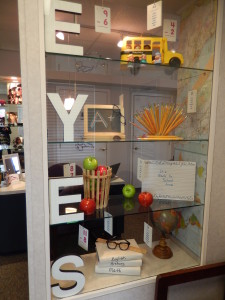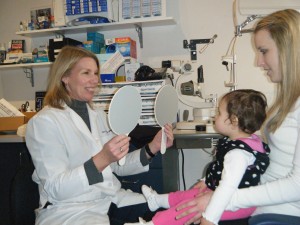Did your child pass the vision screening administered at school last year? Did he see the acuity chart tacked to the door at the pediatrician’s office? Although these tests are helpful in spotting a few basic eye problems, they don’t take the place of a comprehensive eye exam. 
Most screening tests simply measure how well your child can see at a distance. Other vision concerns, such as farsightedness, lazy eye, crossed eyes, poor eye coordination, or poor depth perception may go undetected. Often children do not recognize these problems themselves because they have “always seen it this way.”
A comprehensive eye examination includes measurements of the vision at distances far away which is important for seeing the board and playing sports and closer distances which are important for reading, computers and desk work. The exam also includes evaluation of how the eyes work together and the ocular health.
Parents and teachers may be puzzled about a child’s slow progress in school. For example, if a child is farsighted, he will see distant objects clearly, but he may have problems focusing the eyes for close work. The same child who can read the eye chart easily at a distance may have a difficult time seeing words close up in a textbook or on a math worksheet. As a result, reading problems may develop that can affect the student’s learning and achievement.
UV and Children
Most people in the United States are well aware of the harmful effects of ultra-violet (UV) light on skin tissue and the ritual of lathering sunscreen on children while outdoors that has become an accepted part of parental responsibility. Unfortunately the same parents who religiously provide this protection to their children often fail to recognize the risk of UV exposure to the eye. Few parents are aware that UV can be a contributing factor in the early development of cataracts, may cause irritation and burns to the cornea (photokeratitis or snow blindness), and may contribute to the early onset of age-related macular degeneration.
What most parent do not know is that much of the total lifetime exposure to UV will occur prior to the age of 18. Adults don’t spend quite as much time outdoors as children and often wear eyeglasses containing UV protection. Adults are also more likely to wear sunglasses and are protected from UV while driving by their car windshield.
As your optometrist I must advocate for the health and protection of your child’s eyes. “SLIP, SLOP, SLAP and WRAP.” This is a campaign of the American Cancer Society. It advocates that you slip on a shirt, slop on some sunscreen, slap on a hat and wrap on a pair of sunglasses.
Good Vision
Good vision is important for good learning. When a child’s vision is not working properly learning and class participation will suffer. Good vision includes visual acuity, eye health, visual integration and visual skills such as eye teaming, eye focusing and eye motility.
-
Visual Acuity – the ability of the eyes to see and distinguish fine details, the clarity of vision
- Visual Integration – the ability to process and integrate visual information so we can understand what we see
- Eye Teaming – the ability of the eyes to work properly together
- Eye Focusing – the ability of the eyes to easily focus and shift focus to near and distant points
- Eye Motility – the eyes ability to move together
Development of the Eye
At birth the is is 75% smaller than an adult eye. Because of its smaller size, an infant’s vision is far-sighted or hyperopic. Fortunately baby’s have a large amount of accommodation which allows him/her to focus on objects that are close-up. The accuracy of this focusing isn’t refined, but improves.
During the early months of binocular vision development it is important that the baby has clear vision in each eye and that the images in each eye focus on the same place in each retina. Basically this means that there isn’t any significant refractive error such as hyperopia, astigmatism or myopia in either eye and that both eyes are straight and move together.

A comprehensive eye examination before the baby’s first birthday is the best way check the ocular health, binocular vision and refractive status. Westside Optometry participates in the American Optometric Association InfantSee program. Optometrists across the country know the importance of early eye examinations. They have agreed to assess all infants for no charge. If you, a family member or friend have a child 12 months or younger, call our office for a free examination.
3 thoughts to “Children’s Vision”